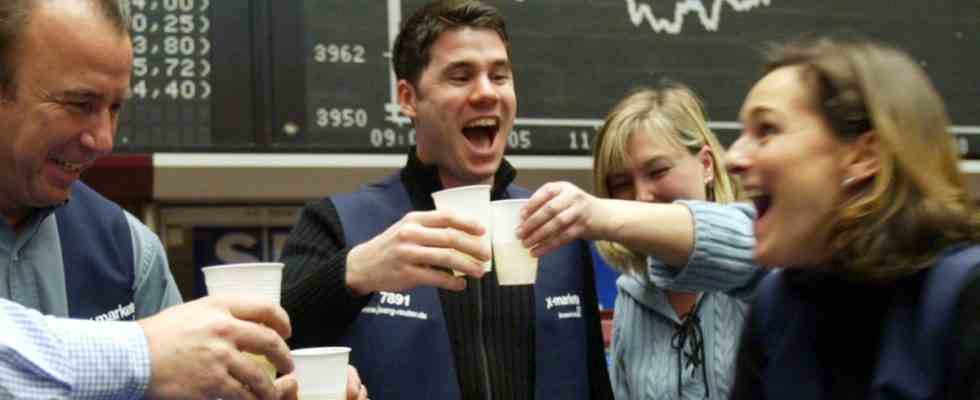A birthday that no one wants to congratulate must feel bad. That the German stock market index TecDax will be 20 years old this Friday? At Deutsche Börse, they know this for sure, but they haven’t prepared birthday wishes. And even the long-time tech expert Christoph Schmidt from the fund company Fegra Capital has to laugh at the TecDax: Even many stock experts do not even know whether this index currently has three or four digits.
On the twentieth anniversary of the stock market index, many people in Germany are just asking themselves: Tec-was? After all, around two-thirds of people know the leading German index Dax with its 40 most important stock market values, but a survey by the market research company Dr. Doeblin however only one in four heard anything at all.
Many people encounter the TecDax in their everyday life: Anyone who picks up their landline phone may have their contract with Deutsche Telekom. Anyone who submits a travel invoice to a company sometimes does so using software from the manufacturer SAP. Architects who design digital building models might use Nemetschek software. And if you are still working from home every day after three years of the pandemic, you can use the Teamviewer software to contact the IT hotline if you have technical problems – all of these companies are members of the German Tech Index.
The fact that the TecDax has risen by around 850 percent since it was launched can definitely be considered a success story: when the index was launched on March 24, 2003, the entire tech industry was actually on the ground. Almost exactly six years earlier to the day, the “Neuer Markt” had started on the Frankfurt trading floor and with it an unprecedented stock market hype.
“Trying to get a dead horse back on its feet.”
“Germans only talk about share tips,” headlined the Bild newspaper in the boom times of tech shares, singer-songwriter Manfred Krug drummed for Volksaktie Telekom, and there was only a hype about the media rights company EM.TV of the Haffa brothers – until then The crash followed in March 2000. Greedy banks, foolish founders, scandals and bankruptcies had caused the Nemax index to collapse from almost 9,000 points at its peak to less than 500 points. “The TecDax was then the stock exchange’s attempt to get a dead horse back on its feet,” says tech analyst Christoph Schmidt today.
When the index started on March 24, 2003, it took over the history of the scandalous Nemax 50 index. Where the Nemax had closed on the previous Friday, the renamed TecDax started on the following Monday when the stock market opened. In order to suggest more solidity, the stock exchange had shrunk the index from 50 to only 30 values from now on. However, 24 of the members of the new index were old acquaintances from the Nemax 50, and only six other stocks were new to the TecDax.
Despite the best of hopes, everything began as it had ended: just 29 days after the start of the supposedly new index, the first scandal afflicted it. At the software manufacturer Ixos, an employee had forged customer orders, and the managers had to have the entire consolidated financial statements corrected. This debacle was the first blow for the TecDax as soon as it started, and the next one was not long in coming.
Because there were notoriously few real technology companies on the German stock exchanges, the stock exchange subsequently filled the young TecDax with solar and wind energy companies. The business smelled of new technology, of unlimited possibilities. Many private investors also hoped that the sun and wind would blow money into their pockets for free. At the peak of the solar hype in 2006, renewable stocks such as Solarworld, Q-Cells and Conergy already accounted for around a third of the TecDax. At the time, some experts mocked the index as “SolarDax”, as a risky bet on the success of the solar titles. The problem? Many of the solar stocks later went bankrupt because the Chinese competition on the world market became too powerful.
In the meantime, the TecDax has digested this price collapse and has even evaded the leading German index Dax. While the TecDax has increased by around 850 percent since it was launched, the leading German index has not even managed to increase its price by 500 percent. Above all, the decade of cheap money after 2012 was able to lift technology stocks, allowing many investors to return to risk – and the tech index to overtake the leading index.
In the meantime, the TecDax includes very different companies: With Deutsche Telekom, Freenet or Telefonica, a whole range of telecommunications providers are included, which among investors have the reputation of predictable business. The index also includes several medical technology companies such as Eckert and Ziegler, Carl Zeiss Meditec and Siemens Healthineers. And meanwhile, with software providers such as SAP, Software AG or Teamviewer, some classic tech companies are also represented in the index.
Nevertheless, many promising tech companies from Germany do not dare to go public in their own country, raising money from large investors or on the much larger US stock exchanges. “Many German investors are simply too risk-averse,” says tech expert Christoph Schmidt of Fegra Capital. “That applies to large institutional investors as well as to private investors.”
Perhaps the stock market is a reflection of this: In Germany, there are only three ETF index followers that can be traded, with which investors can follow the TecDax technology index one-to-one. “An excellent choice for investors,” says Dax manager Serkan Batir from the index subsidiary of Deutsche Börse when asked. The papers currently contain less than one billion euros in total, which is an almost manageable number by the standards of the stock market. “The bitter truth,” says stock expert Schmidt, “simply nobody looks at the TecDax.”

